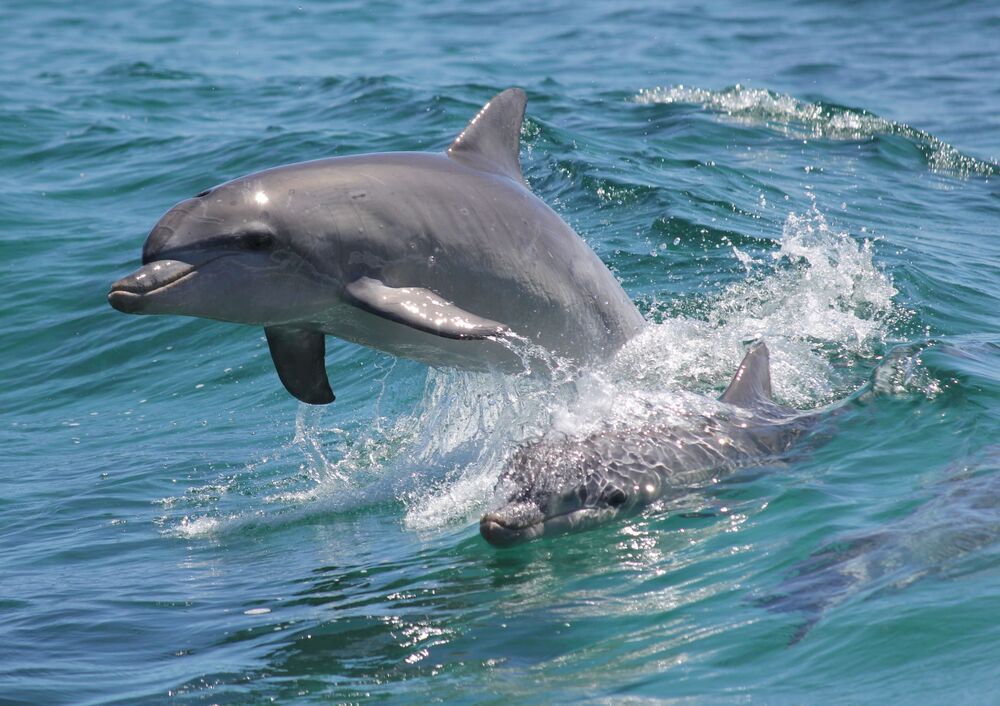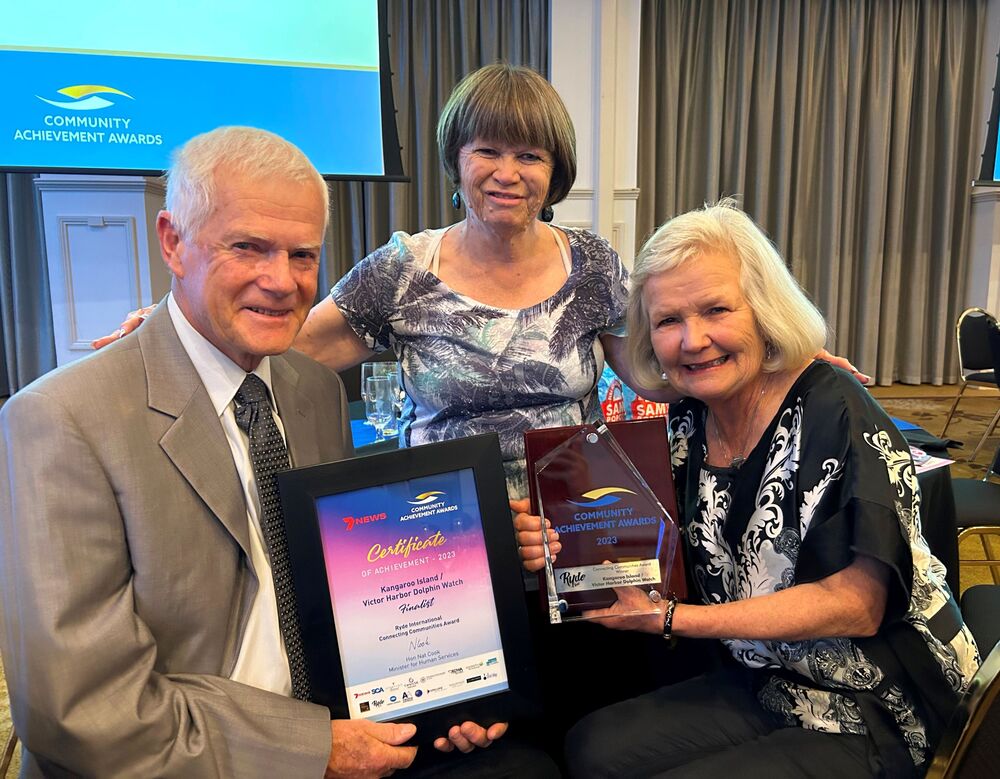Dolphin Watch: Guardians of the southern seas
Anna Kantilaftas
02 March 2024, 7:30 PM
 Bottlenose dolphin Female & New Calf North Cape KI-Fred Peters
Bottlenose dolphin Female & New Calf North Cape KI-Fred PetersIn the crisp blue waters off the south coast of South Australia, a dedicated team led by passionate couple Tony and Phyll Bartram is making waves by monitoring dolphin populations across the Fleurieu Peninsula and Kangaroo Island.
Kangaroo Island / Victor Harbor Dolphin Watch was born in 2005 in Kangaroo Island and expanded to Victor Harbor in 2011. Since then, it has evolved into a compelling tale of citizen science, community engagement, and a profound connection with the ocean's most playful inhabitants.
From its early days as a program designed for senior secondary students, Dolphin Watch has grown into a volunteer-based initiative. Tony Bartram, then a Marine and Environmental Education Coordinator for Kangaroo Island Community Education, played a pivotal role in its development He retired early in 2008 to concentrate on Dolphin Watch, with hopes of making a difference in the world.
The team's efforts extend between Victor Harbor and Kangaroo Island, with a significant focus on Dashwood Bay, where they observe a nursery of dolphins, including mothers, calves, and juveniles, nearly 94 percent of the time.
“We are working hard to gain the greatest protection possible for this precious dolphin habitat,” Tony says.

Bottlenose dolphin Female & Calf Dashwood Bay KI-Tony Bartram
“Dolphin Watch is a citizen science project, which takes community volunteers of all ages on the water to gather vital baseline data with respect to dolphin population groups in our regional waters. Photographic identification techniques, recognised as world’s best practice, are employed… We conduct monthly research surveys on KI and in Victor Harbor, and have regular data analysis workshops.”
The unobtrusive photographic identification techniques reveal not just numbers but intricate details of dolphin behaviours. These methods have led to groundbreaking discoveries, including newly-documented teachings between mother and calf, the way bottlenose dolphins grieve, and the travel patterns of dolphins between mainland South Australia and Kangaroo Island. The research has made a significant contribution to marine science.
“A very poignant memory was provided when female dolphin Tiki was observed carrying her stillborn calf, grieving terribly, and all the other pod members supporting her in a virtual funeral cortege,” Tony says.
“We observed and recorded a Bottlenose dolphin eating a stingray. While doing this, the female dolphin was teaching two of her calves how to achieve this safely. To our knowledge, this is the first time this has been recorded anywhere in the world. This was extremely exciting. There are so many memories provided by these fascinating sentient beings, which are so powerful but playful and so perfectly adapted to their environment.”
Coastlines joined a survey expedition this summer, to observe the observers at work in Encounter Bay on the Big Duck Tours boat.
Within moments leaving the Causeway dock, a large pod of dolphins breached the water alongside, curiously darting in and around the vessel as volunteers clicked their cameras in a bid to collect as much information as possible.
With low swells providing an ideal setting, Victor Harbor Dolphin Watch manager Nedra Haines emphasises the good fortune of having such wonders in our own backyard.
“We’re lucky to have this on our doorstep. No matter how many times I do it, I never get sick of it,” she says.
At last count, the local dolphin population stood at approximately 130. Individuals like 'Flap,' easily identifiable by its dorsal fin split in half and folded, make regular appearances. For volunteers like Nedra, these mammals hold an important place in their hearts.
“I have many favourite dolphins, like Flap, Sushi, and Scapa. I have seen them for the last 12 years, and seen them have calves. They are like friends and some have even been named after things that are important to me...it’s sort of like a living breathing memento,” she says.
Phyll reveals a concerning trend in a higher-than-normal mortality rate for dolphins in South Australia. Despite the challenges, there is an underlying optimism. “We want to save the Earth, and we are in a position to do so…. all we have to do is save the Southern Ocean, which lies between us and Antarctica. We save that, and we solve a part of the bigger problems plaguing this planet,” she says.
Nedra, who transitioned from a volunteer at the South Australian Whale Centre to play an integral part in Dolphin Watch, encapsulates the essence of the project.
"I love many aspects of Dolphin Watch,” she says. “I’m continuously learning something new about these incredible animals, working on photography skills, and also data.
"Another great part of being involved in Dolphin Watch is seeing people from many different aspects of life, with a shared passion for the ocean and dolphins, coming together and making long-lasting friendships."
From its inception, Dolphin Watch has not only provided vital baseline data on dolphin populations but has also contributed groundbreaking findings. The revelation that dolphins from mainland South Australia, especially Victor Harbor, cross over to Kangaroo Island and return has rewritten scientific understanding of the animals.
The Dolphin Watch initiative stands as a beacon of community-driven marine conservation, and has been recognised with awards for its transformative impact.
Reflecting on the journey to get the program to where it is today, the Bartrams express their pride in not only spectacular findings and surveillance of the playful and curious oceanic inhabitants, but also the group’s advocacy against invasive research techniques. They envision a future where dolphins in regional waters are shielded from unnecessary dangers, and speak passionately about the dangers of biopsy darting, tagging, and similar techniques.

Tony, Nedra & Phyll post award presentation - Awards Dinner Nov 2023
The Dolphin Watch story is a testament to the power of collective action and the enduring connection between humanity and the ocean. The Dolphin Watch team remains steadfast in its mission, tirelessly working to safeguard the dolphins inhabiting the waters of South Australia. Through their lens, they capture not just the grace of dolphins but the essence of a community united in its commitment to the ocean's wellbeing.
For more information, visit kangarooislanddolphinwatch.com.au/
Proudly supported by:
